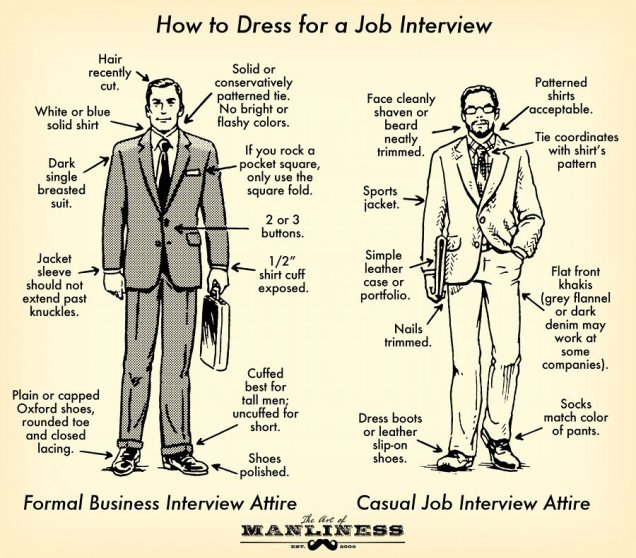
Outside of Martial Arts and the Sears Catalogue, a “Power Stance” can be a great tool for a job seeker. It is both a method of warming up before an interview by increasing your self-confidence and a way to express and maintain that confidence during an interview. It’s also great for sales people, public speakers, and superheroes.
While sitting, keep your back straight with arms either folded or with your arms at your sides with hands on hips. Legs can be angled in any direction so long and your head is aimed at the central audience. Add a bit of style if your whole body is aimed at the audience and cross a leg – but do so in a way that suggests you have the power. Project confidence with an open posture. To avoid projecting entitlement or arrogance, add a smile. Be serious if you must, but tilt your head ever so slightly so as to add a sense of fluid humanity – and always dress the right way!
What to Wear (For Men):

The golden rule is that dressing conservatively with formal attire is an approach that never loses. Always dress a little bit better than you might while working in the position you’re applying for. See the graphic below!

What to Wear (For Women):
Women have a little bit more leeway when it comes to clothing and style options for interviews. Skirts, dresses, pant suits, blazers, heels, flats – there’s a plethora of choices to navigate, so as a woman dressing yourself for a job interview tends to be overwhelming. Here are some helpful hints to get you ready for the big interview.

As with men, conservative and formal is usually the way to go. Wondering if something is appropriate to wear to an interview? Think “high school dress code” – no exposed shoulders, no short skirts, no midriff (please).
If you wear makeup or nail polish, ensure you go for a poised and natural look. Dress in a soft, neutral colour palette. You may want to add one coloured piece to your outfit, to make it pop and ensure the interviewer remembers you. Keep any accessories simple and understated.
Our Summery Summary:
As summer approaches and the hiring season ramps up, knowing what to wear to your interview is vital. Make sure you wear temperature-appropriate clothing (AKA, avoid wool suits in the summertime) and remember to keep it professional and conservative.
We know it’s 2017 and our society is a lot more tolerant and encouraging of individuality than it once was, but you may want to remove any facial piercings and other loud jewellery as well as cover any visible tattoos for your interview. You don’t want to draw focus away from your qualifications and experience, and interviewers can find such things distracting. It’s good to give off a neutral appearance until you can get a sense of the company’s corporate culture.
On top of developing a strong power stance, it may be wise to develop a power ensemble: your go-to outfit for a successful interview. Above all else, make sure you wear something you’re comfortable in. Comfort is the key to confidence and confidence is the key to nailing your interview!
Put your ‘Power Stance’ to the test by entering our #MyPotential2017 Instagram Contest! It’s super easy, and you could win a $100 Pre-paid Gift Card! Click here for full details.
This blog post was produced and contributed by Kaily Schell and Jason D. Smith of The Career Foundation.
T.M. Lewin, based in the U.K., also shared with us an informative infographic to help you crack the office dress code. Check it out below!



